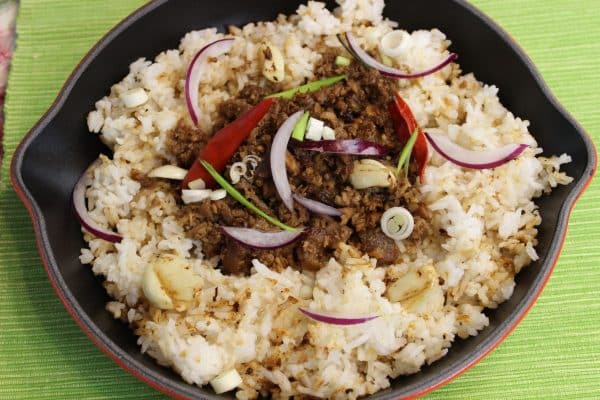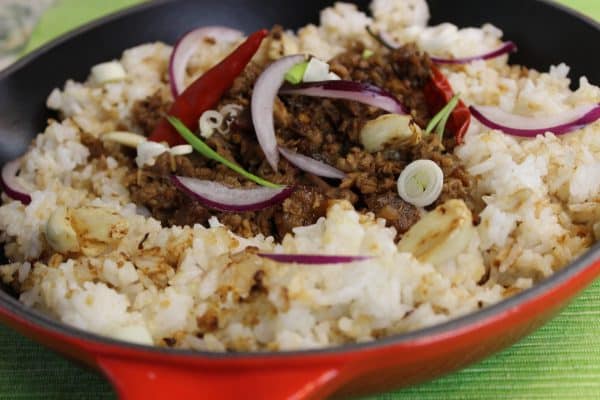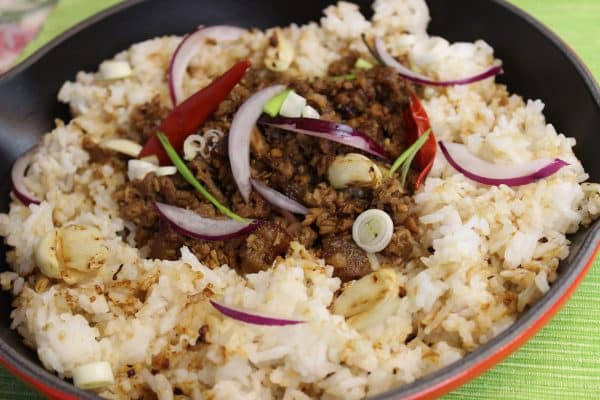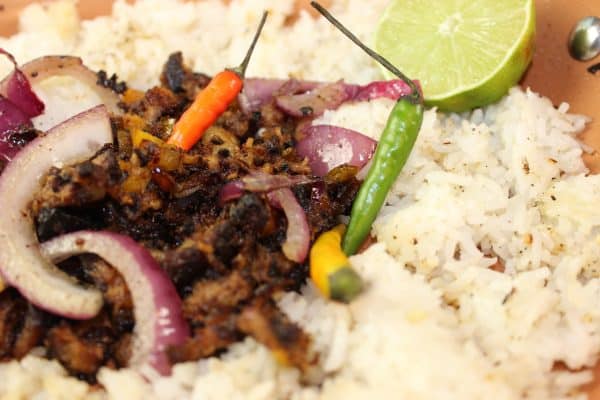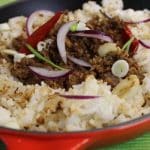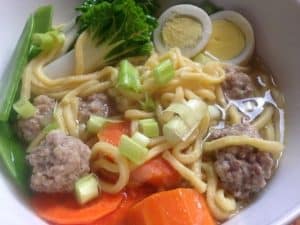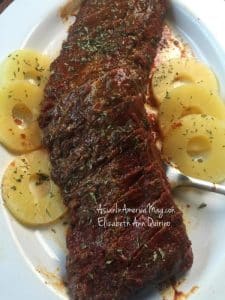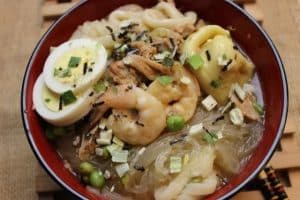Pork Sisig Garlic Rice
As an Amazon Associate and member of other affiliate programs, I earn from qualifying purchases.
What happens when a bowl of Sinangag (garlic fried rice) meets Pork Sisig? Then the dining table explodes with flavors and you have a bigger bowl of Sisig Rice. Garlic fried rice and Sisig are two of the most favorite Filipino dishes today.
But before that happens, you should have leftovers of each. If you have rice leftovers in the refrigerator, then that’s ideal. If you have pork sisig (roasted and braised pork cubes) or even lechon kawali leftovers, then it’s even perfect.
It is hard for our household to stay away from cooked rice. In most Filipino homes, rice is the staple food and we have it with almost every meal, including breakfast. The Kulinarya cookbook (2nd edition) explains there are at least 15 ways with rice. But for this recipe, I chose cooked Jasmine white rice, a family favorite of ours.
There is no magic technique to cooking sinangag. The sizzling garlic and its aroma from the skillet surges fast around the kitchen when I’m making garlic rice. Then after a few swirls of the rice grains around the skillet, adding the sisig’s crisp pork bits makes it just perfect.
I have known pork sisig as an appetizer since I was a child. At our home in Tarlac years ago, my dad often enjoyed a sisig appetizer with his chilled San Miguel Beer, his beverage daily at 6 o’clock. If my uncles came to visit, then there was always sisig appetizers to go with the beer served to them.
Nowadays, to my amazement, Sisig has become popular here in America in the last few years. A long time ago in the 90s, sisig was not as well-known as it is today in America. It only took a few Filipino restaurants to spark the Sisig fire and make everyone ask for it all the time. There are even sisig variations of different meats, seafoods and even vegetarian versions on restaurant menus now.
In the Kulinarya cookbook, pork sisig’s is defined as ‘thrice-cooked pork’ and described as a dish originating from Pampanga. Originally, pork ears, cheeks and jowls are boiled, then grilled over charcoal until nearly charred, are chopped and mixed with chicken liver, onions, calamansi, chilies and served sizzling hot on a cast iron skillet.
To simplify cooking sisig in my American kitchen, I used a slab of pork belly and cooked it like Lechon Kawali in the oven. Pork sisig is defined by a variety of flavors and textures but predominantly one can savor the salty, fiery spiciness of bird’s eye chilies and hints of calamansi-citrus all over the crunchy bits.
Sisig rice is my version of combined favorites – sinangag and pork sisig at the same time. When there’s garlic rice, then it’s comfort food for me. But if sisig is added to it, then it becomes a Filipino dish that’s absolutely heaven.
Pork Sisig Garlic Rice
Ingredients
- 4 Tablespoons vegetable oil
- 4 whole garlic cloves peeled, minced garlic cloves
- 4 cups cooked white rice refrigerated at least 1 day
- 1 whole large red onion sliced
- 2 cups cooked pork sisig see past blog post for recipe
- 1 piece siling labuyo (bird's eye chilies) sliced
- 2 Tablespoons lemon juice or calamansi juice
- 1 teaspoon salt
- 1 teaspoon black pepper
- 1 stalk scallion greens chopped, for garnish
Instructions
- Refrigerate cooked white rice for at least one day. Set aside.
- Cook the pork sisig and refrigerate leftovers. (See previous blog post recipe-- click here).
- The next day, cut up the pork sisig into tiny, pea-sized cubes. Set aside.
- In a large skillet, over medium high heat, add the vegetable oil. When oil is hot enough after 1 to 2 minutes, sauté the garlic. Add the cooked rice. Season with salt and black pepper. Shove the rice to the side of the skillet.
- Using the same skillet and cooking oil, sauté the onions. When the onions become translucent after 1 minutes, add the pork sisig leftovers. Pan sear the meat well for 1 to 2 minutes. Sprinkle the sliced bird's eye chilies, calamansi (or lemon juice, salt and black pepper.
- In the skillet, mix and combine all the ingredients till well incorporated.
- Garnish with chopped scallions. Serve warm.
- Cook’s Comments: if desired, add more sliced bird’s eye chilies (siling labuyo). The Filipino Pork Sisig is traditionally cooked with pork. In fact, its origins which trace back to the province of Pampanga in the Philippines use the leftover lechon pig's head and make sisig from the cheeks and ears. If preferred, you can also make sisig with chicken.
Nutrition
Nutrition Notes: The nutrition information provided is an estimate and will vary based on cooking methods and brands of ingredients used.
Kulinarya: A Guidebook to Philippine Cuisine (Expanded Second Edition, Anvil Publishing) This is one of the best Philippine cookbooks around that is a great resource for beginner home cooks or the formally-trained culinary expert. The book, through the Asia Society brings together six of the Philippine’s most prominent chefs: Glenda Barretto, Claude Tayag, Conrad Calalang, Margarita Fores, Myrna Segismundo, and Jessie Sincioco with full color photographs by Neal Oshima. The renowned chefs share their talents, passion and knowledge of Philippine cuisine to provide readers a better understanding and appreciation of the culture and country through a wide range of classic recipes. The second expanded edition follows the success of the Kulinarya Guidebook. This cookbook provides the necessary information for cooking methods and great practices for Filipino Cuisine. Kulinarya is available where most cookbooks are sold and at online sources (see my Amazon affiliate line up of products used for this recipe).
-
Disclosure: This cookbook was a gift from Tuttle Publishing. I was not paid to do a review or cook from it. But I will gladly recommend it as a resource for classic Filipino recipes.
-
COPYRIGHT NOTICE: Hello, Friends! All the images and content on this blog are COPYRIGHT PROTECTED and owned by my media company Besa-Quirino LLC. This means BY LAW you are NOT allowed to copy, scrape, lift, frame, plagiarize or use my photos and recipe content I wrote, on your website,books, films, television shows or videos without my permission. If you want to republish this recipe or content on another website, video or news article,or media outlets mentioned above please ASK my permission, re-write it in your own words and simply link back to this blog to give proper attribution. It’s the legal thing to do. Thank you. Email me at [email protected]

